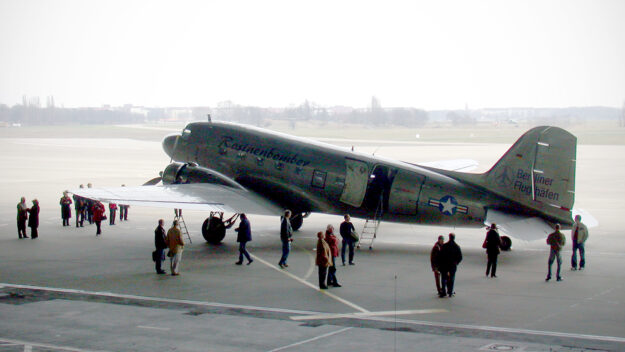The Berlin Airlift (german: Berliner Luftbrücke / ‘Berlin air bridge’) was organized by the Western Allies, British and U.S. America in particular, to support and supplly West Berlin with food and goods during the soviet Berlin Blockade 1948/1949.
Exploring the Berlin Airlift and its Impact
In the aftermath of World War II, Berlin found itself divided both physically and politically. West Berlin was a city on the brink of collapse, its people suffering from widespread hunger and despair. The Soviet Union had cut West Berlin off its ties – the so called Berlin Blockade made it close to impossible to either leave or enter the city.
Yet, in the face of adversity, an extraordinary feat of resilience took place – the Berlin Airlift. This monumental event, which lasted from 1948 to 1949, saw Allied forces supply the city with food, fuel, and other essential resources, using airplanes to transport supplies amidst the Soviet blockade. The courage and determination displayed during the Berlin Airlift captured the world’s attention, becoming a symbol of hope and determination
Historical context of the Berlin Airlift
As the Second World War came to an end, Germany was divided into four zones, each controlled by one of the four major Allied powers – the United States, the Soviet Union, Britain, and France. Berlin, located deep within Soviet-controlled East Germany, was also divided into four sectors, each controlled by one of the Allied powers.
However, as the Cold War intensified, the relationship between the Soviet Union and the Western Allies deteriorated. In an attempt to consolidate control over Berlin, the Soviet Union cut off all surface transportation links to the city in June 1948, effectively imposing a blockade. The Soviet intention was to isolate West Berlin and force the Western Allies to abandon the city.
The logistics of the Berlin Airlift
The blockade of Berlin was a direct response to the introduction of a new currency in West Germany, known as the Deutsche Mark. The Soviets saw this as a threat to their control over East Germany and decided to take action. On June 24, 1948, all rail, road, and canal access to West Berlin was blocked, leaving the city in a state of crisis.
In response, the Western Allies launched the Berlin Airlift to provide the necessary supplies for the people of Berlin. The airlift operation began on June 26, 1948, and continued for over a year. It was a massive logistical undertaking that required the cooperation of multiple nations and the mobilization of hundreds of aircraft.
Challenges faced during the Berlin Airlift
The airlift operation involved a constant stream of cargo planes flying into West Berlin, delivering much-needed supplies such as food, coal, and medical aid. The planes would land at one of the three designated airports in West Berlin – Tempelhof, Gatow, and Tegel – where the supplies would be unloaded and distributed to the people.
Impact and significance of the Berlin Airlift
The Berlin Airlift was not without its challenges. The Soviet Union attempted to disrupt the operation by harassing the supply planes, using tactics such as shining searchlights into the cockpits and flying dangerously close to the aircraft. However, the Allied pilots remained resolute and continued their missions, often risking their lives to ensure the success of the airlift.
Another major challenge was the harsh winter weather. The bitterly cold temperatures and heavy snowfall made flying conditions treacherous. The pilots had to navigate through blizzards and icy conditions, often relying on instinct and skill to complete their missions. Despite these challenges, the airlift continued without interruption, proving the unwavering determination of the Allied forces and their commitment to the people of Berlin.
Lessons learned from the Berlin Airlift
The Berlin Airlift had a profound impact on the people of Berlin and the broader geopolitical landscape. First and foremost, it saved West Berlin from collapse and provided a lifeline for its citizens. The airlift ensured that the people of West Berlin had access to food, fuel, and other essential supplies, preventing a humanitarian catastrophe.
Moreover, the Berlin Airlift became a powerful symbol of hope and resilience. It demonstrated the willingness of the Western Allies to stand up to Soviet aggression and protect the freedom and well-being of the people of Berlin. The courage and determination displayed during the airlift inspired people around the world and served as a reminder of the indomitable human spirit.
Commemorating the Berlin Airlift
The Berlin Airlift taught valuable lessons about the power of unity and cooperation. It showcased the ability of nations to come together in times of crisis and work towards a common goal. The success of the Berlin Airlift was made possible by the collaboration between the United States, Britain, France, and their respective allies. It served as a testament to the strength of international partnerships and the importance of diplomacy in resolving conflicts.
The Berlin Airlift is commemorated in various ways to honor the bravery and sacrifice of those involved. The Berlin Airlift Memorial, located at Tempelhof Airport, pays tribute to the pilots and crews who participated in the airlift.
The legacy of the Berlin Airlift extends far beyond the boundaries of Berlin. It serves as a reminder of the triumph of the human spirit over adversity and the power of compassion and cooperation in times of crisis. The Berlin Airlift demonstrated that even in the darkest of times, hope can prevail, and people can come together to overcome seemingly insurmountable challenges.
The Berlin Airlift also had a lasting impact on the geopolitical landscape. It marked a turning point in the Cold War and signaled the determination of the Western Allies to protect the freedom and independence of West Berlin.
Berlin Airlift Figures:
- Duration of Berlin Airlift: 26. June 1948 – 30. September 1949
- Total number of flights: 277.569
- Total number of accidents: 17 (83 dead)
- Total fright flown to Berlin: 2.325.509,6 t
- Total coal flown to Berlin: 1.586.099,3 t
- Total food flown to Berlin: 536.705,3 t
- Total other fright flown to Berlin: 202.774,4 t
- 733 ‘incidents’ happende during crossing the Soviet Sector – Raisin Bombers were approached by Soviet fighter jets, glared by searchlights etc.
Source: https://de.wikipedia.org/wiki/Berliner_Luftbücke (german)
English language resources about Berlin Airlift:
- Page at Wikipedia about Berlin Raisin Bombers
- Page at Wikipedia about the Berlin Blockade
- Impressions of a Berlin Airlift Pilot – The Power of Hope and Freedom
a Personal Essay by Gail Halvorsen at germany.info (official website of German Missions in the United States)
Do you have and thoughts, suggestions, additional recommendations or comments? Please feel free to leave your comment below. Thank you!

